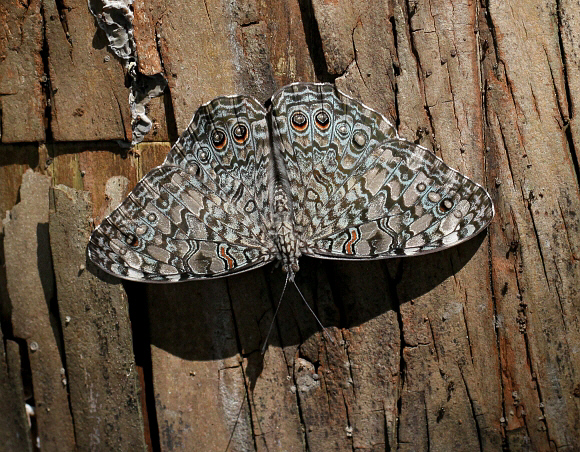 Hamadryas februa male, Yarinacocha, Ucayali, Peru – Adrian Hoskins
Hamadryas februa male, Yarinacocha, Ucayali, Peru – Adrian Hoskins
There are several reasons for this. Many Nymphalids including Hamadryas, Prepona, Panacea and the Red Admiral Vanessa atalanta habitually bask high up on tree trunks, with wings outspread, and head downwards. They often appear to be observing the activity below them, and males certainly use these high vantage points to watch out for females flying below them in the forest. An additional advantage of adopting this position is that sunlight hits the wings more squarely, allowing the butterflies to warm themselves more quickly.
Another reason is linked to aerodynamics. Studies have demonstrated that butterflies get greater ‘lift’ if they take off from a head-downwards position. The hibernating Comma pictured below has chosen a small branch just a few inches above the ground as it’s over-wintering site. The butterflies probably make use of the heat reflected up from the leaf litter, and in conjunction with the more efficient head-downwards take-off, can become airborne more easily on the cold but sunny days of late winter and early spring.
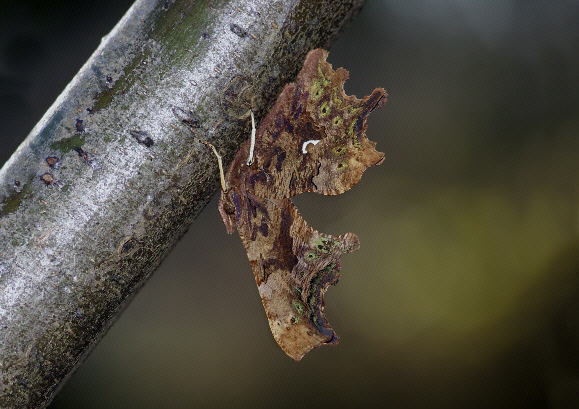
Comma Polygonia c-album, hibernating openly under a low branch – Adrian Hoskins
Tropical Riodinids such as Eurybia habitually rest beneath low growing foliage, and probably make use of the same factors to enable them to take flight very rapidly, to intercept potential mates.
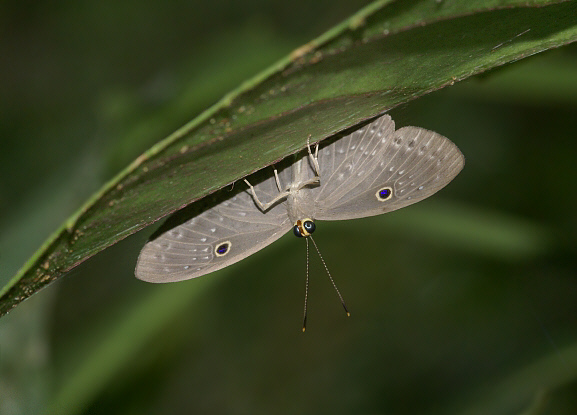
Eurybia species, probably molochina, Madre de Dios, Peru – Adrian Hoskins
Where do butterflies go when it rains ?
Most species shelter under leaves when it rains. They can often detect the approach of wet or windy weather several hours before it’s arrival ( by sensing changes in humidity and air pressure ), and take shelter well in advance of rainfall. I’ve observed this many times especially in the neotropics when Cattlehearts, Sisters and many other species suddenly disappear under leaves even when the sun is shining. You can be sure however that when they do so things are on the change. Clouds quickly roll in, and an hour later it’s pelting down. There is a short account of my observation of similar behaviour by Gonepteryx rhamni in England, on the Brimstone page.
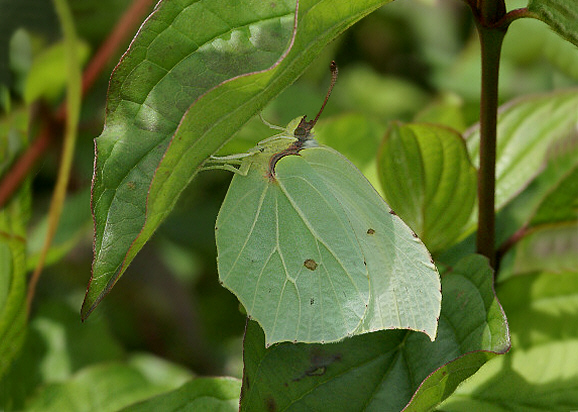 Gonepteryx rhamni roosts under leaves at night or in wet weather – Adrian Hoskins
Gonepteryx rhamni roosts under leaves at night or in wet weather – Adrian Hoskins
Not all butterflies shelter under leaves though. Some such as Peacocks hide in rabbit burrows, while Commas go into log piles or hollow tree trunks, and Orange tips just sit it out on the surface of a leaf or on a flower head. Blues, browns and most skippers rest openly on grasses in dry weather, but the threat of rain sends them deep into grass tussocks for shelter.
Dingy Skippers stay out in the open even during prolonged spells of bad weather – in May 2006, I studied one particular female Dingy Skipper which spent no less than 13 days sitting on the top of a knapweed plant, with it’s wings wrapped tightly around a dead flower head. It endured heavy rain, hail, sleet and strong winds during this period, with no opportunity to feed. The butterfly is superbly camouflaged when resting on knapweed seed-heads, where it is overlooked by insectivorous birds. By roosting high on the seed-head, it is also able to escape predation by rodents, which might more easily locate an insect that chose to hide amongst grasses at ground level.
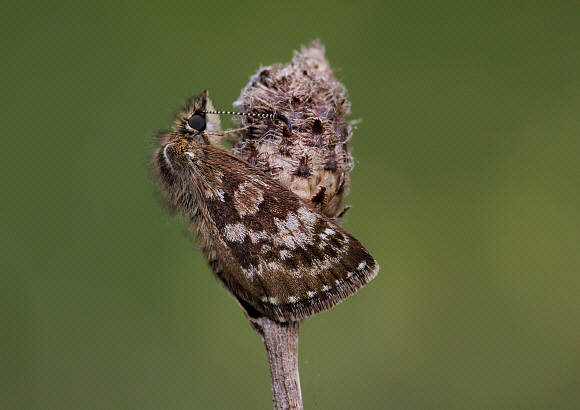 Dingy Skipper, female at roost, Selborne, Hampshire. During prolonged periods of wet weather, the butterflies remain out in the open for a week or more, with their wings wrapped tightly around the dead flower heads of knapweed plants – Adrian Hoskins
Dingy Skipper, female at roost, Selborne, Hampshire. During prolonged periods of wet weather, the butterflies remain out in the open for a week or more, with their wings wrapped tightly around the dead flower heads of knapweed plants – Adrian Hoskins
Why do butterflies migrate ?
When butterflies first appeared on Earth, the present day continents were all connected to form one giant land mass. Nature tries to fill every available niche, so butterflies would have naturally been nomadic, their colonies moving seasonally from one area to another in search of suitable habitats.
As the continents drifted apart, species with weak flight became increasingly unable to cross newly forming natural barriers such as oceans and mountain ranges. Certain species however were more robust, and managed to overcome the barriers. In some species the inclination to migrate became imprinted genetically, and they still migrate today – if/when environmental conditions are suitable.
The most famous migratory butterfly is the Monarch Danaus plexippus, which migrates annually over a distance of 2000 miles ( 3200km ) between it’s northern breeding territories in Canada, and it’s southern over-wintering grounds in Mexico. Read more about the Monarch here.
The story of the Monarch – click here.
Why do Hairstreaks rub their wings together ?
Hairstreaks usually have a pattern of lines or stripes on the underside wings. These, in combination with ocelli ( false eye markings ) and short tails ( false antennae ) act to divert attention away from the head, and towards the outer edge of the hindwings. By oscillating the wings, the tails are made to wiggle like antennae, further increasing the illusion that the butterfly is ‘back to front’. Attacking birds will always aim at the head of a butterfly, but are tricked into aiming at the tail. The butterfly is thus able to escape in the opposite direction unharmed. Another reason for wing-rubbing is that male Hairstreaks have patches of specialised wing scales – ‘androconia’, located on their upperside forewings. Sacs at the base of these scales contain pheromones. Rubbing the wings together helps to disseminate the pheromones, which attract females and induce them to mate.
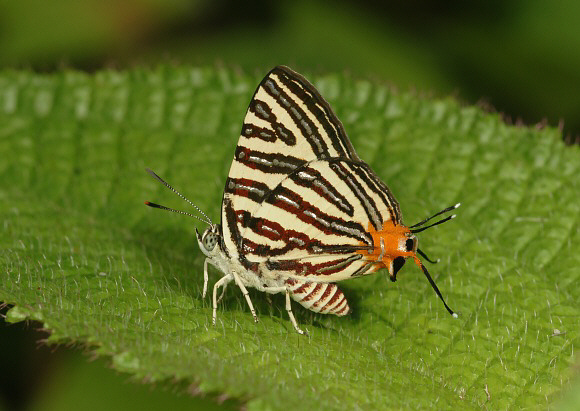 Spindasis seliga, Gopeng, West Malaysia – Adrian Hoskins
Spindasis seliga, Gopeng, West Malaysia – Adrian Hoskins
Why do Whites bask with their wings half-open ?
This activity is called reflectance basking. Butterflies with dark wings usually open them fully when basking, to expose the maximum area to the sun’s rays, enabling them to warm up rapidly and gain energy. Whites, Blues and Coppers however have wing surfaces which reflect, rather than absorb solar energy. Consequently they bask with their wings half open, so that the heat produced by sunlight falling on the dark thorax is contained within the ‘cage’ of the half-open wings, rather than being dispersed on the breeze.
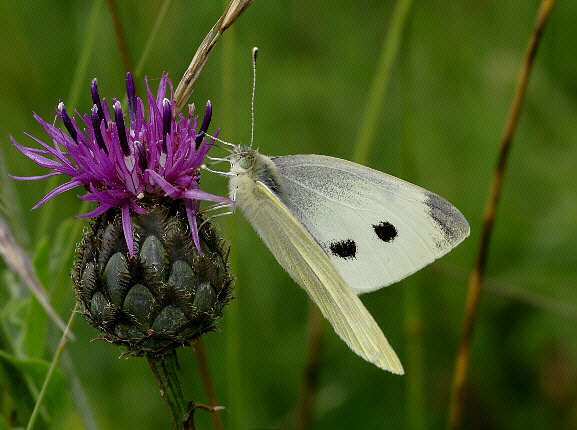 Small White Pieris rapae, 2nd brood female, Noar Hill, Hampshire – Adrian Hoskins
Small White Pieris rapae, 2nd brood female, Noar Hill, Hampshire – Adrian Hoskins
How much rainforest is destroyed every year ?
A very difficult question to answer, because some areas are entirely destroyed, while other areas are left semi-intact, but severely degraded.
In excess of 10,000 square miles ( 2.6 million hectares ) of the Amazon rainforest is deliberately burnt down every year, primarily to make way for cattle pastures. These pastures are very poor in nutrients, so support only very small numbers of cattle. The pastures are burned annually to promote new grass growth and to destroy cattle parasites. These fires rage uncontrolled, setting fire to further areas of forest. Deforested areas are much hotter and drier than the rainforests – consequently the average temperature of the entire region rises and the humidity falls even more dramatically. This causes major changes in the vegetation structure of the remaining areas of rainforest, leading to reduced biodiversity even in protected areas.
Please visit the Rainforests pages to see how YOU can help to protect the areas that remain.
What are the red bits on this Marbled White ?
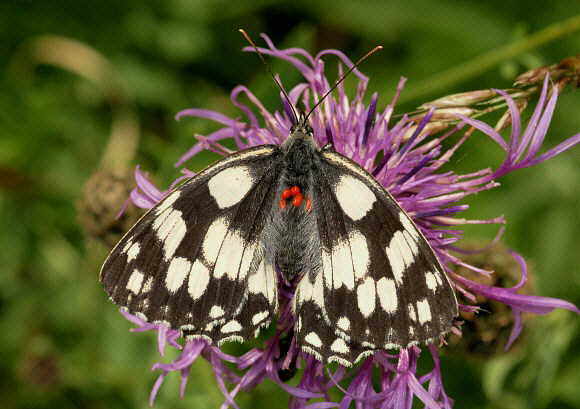 Marbled White Melanargia galathea, with Trombidium breei mites on thorax – Adrian Hoskins
Marbled White Melanargia galathea, with Trombidium breei mites on thorax – Adrian Hoskins
Adult butterflies, particularly the males of Meadow Brown Maniola jurtina, Marbled White Melanargia galathea, and Common Blue Polyommatus icarus are commonly parasitised by these red mites Trombidium breei, which normally attach themselves to the thorax of the butterfly.
They transfer from host to host when the butterflies alight to nectar at flowers. Studies on Meadow Browns have shown that the mites have no detectable effect on the flight performance, orientation ability or lifespan.
Why do Danaines feed at dry, dead plant stems ?
The habit which butterflies have of feeding at dry, dead plant stalks is not confined to Danaines it is also very common amongst Ithomiines, and not unknown amongst Satyrines and Nymphalines. I’ve even seen White Admirals doing it in Britain.
Only male butterflies indulge in this habit. The purpose is to acquire pyrrolizidine alkaloids, which in the case of Danaines and Ithomiines are chemically converted into pheromones. These are later disseminated via ‘hair pencil’ scales on the abdomen ( Danaines ) or wings ( Ithomiines ), to entice females into copulation.
The alkaloids are also known to be toxic to birds, inducing vomiting, so that a bird which has tasted an Ithomiine or Danaine is unlikely to attack another similarly patterned butterfly. It is also likely that the alkaloids are passed to females during copulation, and may be vital in the production of viable eggs.
How are butterfly populations monitored ?
A ‘transect’ is one of several methods used to monitor butterfly populations. Other methods include ‘mark and recapture’ and ‘species-related estimation’.
Transects
This method involves an individual or group of individuals who undertake a regular weekly walk that follows a fixed route through a butterfly habitat. The route is divided into sections, each representing a different sub-habitat. A transect at a woodland site for example might include a section through a recently coppiced area, another section through a fir plantation, and another through a stand of mature oaks.
The butterflies seen in each section are counted, and the figures compared to those obtained in other sections, or from the same section in past years. The figures do not represent accurate population counts, but are of value in assessing how numbers fluctuate in response to management factors such as grazing or coppicing regimes.
Unfortunately the method has many disadvantages – a) conspicuous species such as Small Whites or Brimstones can be easily counted, but smaller and duller species such as Dingy Skippers and female Chalkhill Blues tend to be greatly under-estimated; b) butterflies flying in open grassland are more easily counted than those in woodlands; and c) the numbers of each species which are active and observable vary greatly according to climate, local weather conditions, time of day and other factors.
Mark and recapture
This method involves capturing every individual of a particular species, numbering and tagging it by marking it with a spot of paint, and releasing it. The following day the process is repeated, and the number of ‘missing’ butterflies is counted, while ‘new arrivals’ are themselves marked. Over a 2 or 3 week period it is possible to analyse the build up of populations, the lifespan of individuals, and the movement of individuals from one part of the site to another.
The disadvantages are – a) it is not possible to know why individuals go ‘missing’ – do they die, do they disperse or migrate, are they simply copulating or resting and thus not captured ? b) this method works quite well for certain species at small sites, but is impracticable at large sites, and impossible for species such as Purple Hairstreak which spend all day at the top of oak trees.
Species-related estimation
This method uses a combination of ‘field knowledge’ and calculation. An experienced entomologist might e.g. walk around a grassland site counting the numbers of male Chalkhill Blues. Perhaps he / she counts a total of 300 males in an hour.
This is doubled to 600 to take account of the female percentage of the population. Next it is multiplied by a factor which takes into account the area of the site where similar habitat occurs – perhaps the walk only took the entomologist through 10 percent of the habitat, so the figure would be multiplied by 10 to give a total of 6000.
The count only took place for one hour, on one day, but the species may have a flight season lasting several weeks, so other factors must be taken into account : What percentage of the total population had yet emerged ? What percentage were flying during the hour that the count took place ? Various formulae ( arrived at from mark and recapture data ) can be applied to calculate the approximate total population size.
Multiplying the counted number of individuals ( 300 ) by the appropriate factor might result in a total population size as small as 1000, or as large as 20,000, depending on the size of the site, the available habitat, the behaviour of the butterfly, and at what stage in the flight season the count occurred.
The disadvantages of this method are – a) it is highly subjective – for it to have any comparative value, the same entomologist and the same formulae would have to be used at every site; b) areas of a site that appear to be identical may hold vastly different numbers of butterflies – e.g. some areas might have a deeper soil – a factor that affects the vegetation mixture, sward height and microclimate.
What to do with a hibernating butterfly in my house ?
The best course of action is to put the butterfly outside, making sure it is cool and protected from wind and rain, but in a position where the sun will reach it when it is time to awaken in spring.
You could place it within a pile of logs for example, in a hollow tree trunk. The most important thing is that it must have an escape route, and must be protected from birds, and from spiders ( so don’t put it in a shed or greenhouse ).If the butterfly wakes up and flies away on a sunny day in the winter it will find its own way to another safe hiding place.
What is the biggest insect that ever lived ?
Fossils of a prehistoric dragonfly Meganeura monyi from the order Protodonata make it the largest insect ever to be found, with a full wingspan of 30 inches and a body length of 18 inches. The Meganeura dragonfly lived about 250 million years ago until it became extinct at the end of the Paleozoic Era. It flew in Britain and France at a time when the climate in Europe was tropical.
What is the fastest flying butterfly ?
The Monarch Danaus plexippus is thought to be the fastest flying butterfly, with a top speed of up to 20 mph in still air. However several hawkmoths ( Sphingidae ) have been measured at speeds of over 30mph. The fastest flying moth however is the Black Cutworm ( Noctuidae ) Agrotis ipsilon which can reach flight speeds of up to 70mph / 113kph.
